Cite this document
(“Issues and Implementation Considerations Related to Human Resource Research Paper”, n.d.)
Issues and Implementation Considerations Related to Human Resource Research Paper. Retrieved from https://studentshare.org/human-resources/1758721-information-management-systems-issues-and-implementation
Issues and Implementation Considerations Related to Human Resource Research Paper. Retrieved from https://studentshare.org/human-resources/1758721-information-management-systems-issues-and-implementation
(Issues and Implementation Considerations Related to Human Resource Research Paper)
Issues and Implementation Considerations Related to Human Resource Research Paper. https://studentshare.org/human-resources/1758721-information-management-systems-issues-and-implementation.
Issues and Implementation Considerations Related to Human Resource Research Paper. https://studentshare.org/human-resources/1758721-information-management-systems-issues-and-implementation.
“Issues and Implementation Considerations Related to Human Resource Research Paper”, n.d. https://studentshare.org/human-resources/1758721-information-management-systems-issues-and-implementation.


